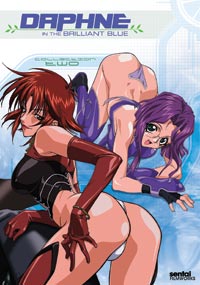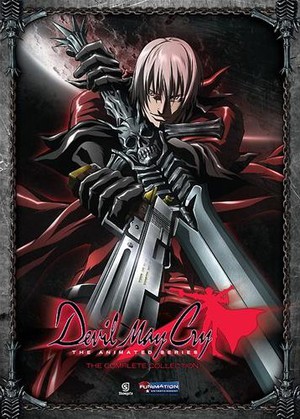Shelf Life
Bringing the Heat
by Erin Finnegan,

None this week
Rental Shelf
Yayoi Kusama I Love Me (live action)
Devil May Cry Complete Series
Heat Guy J Complete Series
Perishable
Daphne in the Brilliant Blue Collection 1 & 2
This week's column includes my first Perishable title. I had not considered that there may be a range within Perishable. I thought Perishable titles ought to be titles I actively condemn, stuff I wish didn't exist to begin with, or failed projects with such low production values that the staff should be ashamed of them. Inasmuch as there is a range of Rental Shelf which extends from the top of the theoretical Netflix queue to the bottom, lowest-priority rental, there's also a range of Perishable. At the top of the Perishable range are titles that I just wouldn't advise anyone to rent. It's not vomit-worthy, it's more like… don't waste your life.
 At first glance, Daphne in the Brilliant Blue looked much more Perishable than it actually is. It's perishable, but not for the reason you may think.
At first glance, Daphne in the Brilliant Blue looked much more Perishable than it actually is. It's perishable, but not for the reason you may think.Daphne is set in the future, apparently after global warming has turned Earth into primarily ocean-covered territory. The technological advances of the future include hover boats, wave control machines, very small underwater breathing apparatuses, and last but perhaps most importantly, the strapless thong.
Our protagonist, Maia, applies for a job at the powerful, science-y FBI-like Ocean Agency, only to fail her exam under mysterious circumstances. She's an orphan who's losing her house, and with no where to turn, she ends up getting a job with Nereids, a quasi-legal catch-all service agency made up of well-endowed ladies who will rescue lost cats or act as bounty hunters for any paying client.
For reasons which go unexplained, the Nereids strip down to bikinis to fight. They wear chaps and cut-off shirts the rest of the time, so it's odd that they seem to need to remove more clothing for a gunfight or hand-to-hand combat. Their lack of clothing never seems to phase the bad guys, either.
The bikinis might make more sense if the Nereids ended up underwater in every episode. Since Daphne takes place on a water world, it's disappointing that the series doesn't take more advantage of the setting, particularly in early episodes. Maia demonstrates her elite underwater skills during the exam, but then most of the episodes take place on land.
Why?!
As humans, our brains naturally try to make connections and invent narratives to explain the outside world. Even as this series slowly befuddled my brain and my thought processes began to grind to a halt, my conscious mind attempted to make up some sort of excuse for the show, some narrative to explain its creation. Here's what I imagine:
Once upon a time, there were two Japanese dudes who were best friends from childhood. One of the boys was shy and quiet and liked science fiction and oceanography, and just wanted to write screenplays. His BFF was an obnoxious dude pushing him to succeed, but with poor suggestions about breaking into anime/film through the porn industry. As they pitched Daphne, the obnoxious dude kept making the character designs sexier and more ridiculous. By some miracle the show was then approved and aired on TV Kanagawa.
It's bizarre to have to clarify that Daphne isn't soft core porn. It's like a future version of Baywatch Nights minus David Hasslehoff. It's like Charlie's Angels with an ugly, lame Charlie. The only similar anime series I've seen is Burst Angel, which has the distinction of being god-awful boring, despite sexy character designs. Daphne isn't that boring. I even laughed a couple of times, but part of the amusement it generated was probably due to my brain cells hemorrhaging as they died. (Daphne is also superior to Burst Angel because there's no lolicon sex object character.)
One would think a show that invents side-less denim shorts would be, well, more misogynistic. It sounds weird to say, but this was surprisingly un-misogynistic and inoffensive. For one thing, the breasts don't bounce. You know what's way more offensive that this show? Mikuru's treatment in The Melancholy of Haruhi Suzumiya. I love the Haruhi anime and novels, but I'm continually offended by Mikuru's asymmetrical breast bouncing, Haruhi costume-raping her, and the fact that when Mikuru is sexually harassed it's played up for laughs. Everything else about the show is fine.
In Daphne, none of the characters within the show make lewd comments about the skimpy outfits. (They're never publicly humiliated like Mikuru, either.) We can only assume that everyone dresses this way in a future where Siberia is a tropical coastline. In hoity-toity filmschool terms, Laura Mulvey's "Male Gaze" is absent from Daphne (except for the gaze of you, the viewer).
In fact, towards the end, there's even an un-sexy shower scene. Maia's past is slowly revealed, and she has an emotional moment in the shower. What the hell?! How can this show exist?!
The dub is loyal and perfectly fine. I feel bad for the dub actors, having to watch this show and think really hard about the characters.[TOP]
 After that I had to cleanse my brain with something more respectable. I love the Viz Pictures line, and I always try to watch, review, or otherwise buy their live action films. I was excited to hear about their New People Artist Series, a series of documentaries on contemporary Japanese fine artists. Specifically I'm looking forward to Traveling with Yoshitomo Nara, but this was the first movie in the series that I got my hands on.
After that I had to cleanse my brain with something more respectable. I love the Viz Pictures line, and I always try to watch, review, or otherwise buy their live action films. I was excited to hear about their New People Artist Series, a series of documentaries on contemporary Japanese fine artists. Specifically I'm looking forward to Traveling with Yoshitomo Nara, but this was the first movie in the series that I got my hands on.From the front and back cover, I mistook Yayoi Kusama for a cross dressing man. In fact, she's an old lady who likes to wear very bright wigs. Kusama's most famous work is probably her penis chair. I mean, it's not called the penis chair, it's called "Accumulation No. 1" and it's this white chair covered with all white phallic things. I had seen the chair in tons of art books but I never knew it was by a Japanese chick.
It turns out Kusama lived in New York City for 13 years, mostly in the 1960s, and took part in the avant-garde art scene at the time. By far the most interesting footage in the film is the footage of a young Kusama running through Central Park, naked and painted in polka dots, in the middle of a sort-of flash mob that she arranged (at the time, they were called "happenings").
Most of the documentary follows Kusuma as she "paints" 50 canvases with a thick black marker for a gallery show. It takes her one year, from one birthday to the next. We get to see her daily routine, and some of her other works. She attends several celebrity-studded awards shows, including one with Takashi Murakami, and she does a weird dance with Beat Takeshi on a Japanese variety show. "Is his comedy funny?" she asks her staff afterwards, since she'd never heard of him. She even receives an award from the Prime Minister, although cameras are not allowed inside.
I really like Kusama's art work a lot, but most of this movie is just following around a sad old lady. She's really starting to feel her age, and at times she's preoccupied with death. "You're all waiting for me to die," she says to her staff at one point. "When I die, sell my paintings for a lot of money." This softens the blow… but it's still painful to watch.
As the title tells us, Kusama loves herself, and her artwork. She continually says that her work is the best in the art world. I think at one point she even calls herself a genius. She's not very humble.
Towards the end of the film, Kusama talks about how she attempted suicide as a teenager because her home life was so bad. She describes laying awake at night as an old lady, unable to sleep and thinking about death. It's the opposite side of the coin of her constant self love.
I was going to recommend this film to art students, because Kusama worked so hard to do something no one had ever done before, and to make it as an artist, and she totally achieved those goals and is recognized all over the world. But all that success doesn't make it suck any less to be really old.
She voluntarily lives in a mental institution. Every day she commutes from the institution to the studio. The film mentions that when Kusama lived in New York, she worked so hard that she was "occasionally hospitalized." I'm left wondering which type of hospital it was.
Kusama's paintings are fun to look at, but she doesn't look like she's having fun making them. She seems compelled to paint, obsessed, and it exhausts her. "In my next life, no more painting," she says. An assistant asks what she may have been in a past life. "A painter," Kusama responds, and then says, "in the next life, a painter."
That's not exactly encouraging.[TOP]
 If Kusama realized her childhood dream of being a painter, Dante in Devil May Cry is living in somebody's childhood fantasy…
If Kusama realized her childhood dream of being a painter, Dante in Devil May Cry is living in somebody's childhood fantasy…I'm convinced that if you're a 12 year old boy, this is the greatest show ever.
I've never played any of the videogames, but I hear this is a pretty loose adaptation anyway, so it shouldn't really matter. I mean, it does matter, because if you actually like the game it's probably really cool to see these characters animated so nicely.
Noah argued that this was perishable, but the production values are too high to put it in the trash. Hisashi Abe and Katsushi Aoki of Vampire Hunter D: Bloodlust designed the characters, and the animation is really solid, probably thanks to Abe and Aoki. I really like these character designs a lot, I think they're memorable and cool. This might be worth renting just because you like their designs. (As a responsible anime fan, you should really watch both Vampire Hunter D movies.)
Unfortunately there are two major problems with this show: The unoriginality of the characters and the episodic nature of the plot.
Dante has a coat that's a mix between Vash's (Trigun) and Alucard's (Hellsing). It's so derivative that sometimes Dante would say something rude, and I'd think "That's weird, Vash would never say that! "
Despite his design, Dante does provide some amusement. If you asked your 5th or 6th grade self about his/her ideal job, you might say something like, "I'd have my own detective agency, and every day I'd eat pizza and strawberry parfaits! I'd have a huuuge sword and gun that shoots magic bullets that kill demons!" That's this show in a nutshell. The detective agency is literally called Devil May Cry, in big neon letters on the building, with Dante's profile at the end of the sign, holding his huge sword and gun.
At least one fine sharpshooter chick (named Lady) with two different colored eyes and a short plaid skirt hands around the office a lot. The reason you know this is a show for 12-year-olds and not 15-year-olds is that Dante never gets laid. Also Lady wears shorts under her skirt.
Spike in Cowboy Bebop says in an early episode that he doesn't want any women, children, or pets around. It's dramatic irony that he ends up with all three. It's less ironic when Patty, a 10-year-old girl with curly ringlets takes up residency in the Devil May Cry offices. Patty is annoying in the same way a little sister can be annoying. In fact, she really drags down the show. On the plus side, thank god she's not there for some sick lolicon reason.
The dub is adequate, but it sounds like Dante sighs before saying each of his lines. That might be in-character, but after a while I thought it was a little annoying.
This show might have been alright, but the episodes are too episodic. Things tie together a little at the end, but it's too little too late. Nothing dramatic is carrying us from one episode to the next. Unlike Cowboy Bebop, the writing isn't strong enough to support individual episodes.
The big bloody finale with all the violent melodrama and cool demons and stuff is probably so much cooler if you're 12. I mean, it's bloody enough that you probably shouldn't be watching this if you're 12, but that's what makes it cool.[TOP]
 Too bad it's not widely appealing to more demographics, like Heat Guy J.
Too bad it's not widely appealing to more demographics, like Heat Guy J.This could be Shelf Worthy if you can get it on sale. $49.95 SRP is too expensive, but for $30 or less this would be a good buy. If anything, Heat Guy J deserves your attention because it's a well-made show with the same director and character designer as Escaflowne, Kazuki Akane and Nobuteru Yūki.
I super-love Nobuteru Yūki's character designs, with the noses so sharp they could kill a man. Some of the characters look so much like Escaflowne characters it's as if they've been recast into a scifi cop show. That's cool - Tezuka recast his characters in his Star System, and if you read Hiroaki Samura's Blade of the Immortal it's hilarious to read his totally unrelated manga Ohikkoshi, which has the same character designs.
I really liked Escaflowne, even though the plot turned into shenanigans part way through (fortunate blood? really?). I really loved the characters (OK, not Merle). Heat Guy J is the inverse of the director's previous work - I couldn't really get into the characters in this, but the plot got better as the series went on.
I suspect foreign money may have gone into Heat Guy J. It aired on MTV2 (back in 2004), the production values are pretty high, and the writing is very episodic. To me that kind of says "Made to hit in America"... but I don't think it ever did, and that's too bad.
The first failure of this show is the title. It's so forgettable! I kept confusing it with Eat Man '98 (a much lousier anime) before I watched it, because Eat rhymes with Heat. The term "heat guy" doesn't even come up until the last three episodes. It refers to Daisuke, our protagonist, who is the one who carries the gun. For half the series I thought the heat man might be J, our protagonist's android sidekick.
J is the most appealing character in this series, and he's a robot. (I guess that's true for a lot of shows, but…) If Heat Guy J is a poor man's Ghost in the Shell: Stand Alone Complex, J is that poor man's Major Kusanagi. Although he can jump extraordinarily high and use his cybernetic eyes to scan people, J is not as advanced as Kusanagi. His walking is a little stiff, and two huge exhaust pipes wrap over his shoulder and expel pent-up steam after extreme physical exertion. I'd say he's about 100 years before GitS technology, but 100 years after our future.
J's signature move is his killing punch. He punches dudes through buildings and cripples humans in a single blow. Much to J's advantage, androids are illegal in the city-state, but when he does meet a contraband android, you know he's met his equal when their fists collide in mid-air.
Heat Guy J uses place as character. While Daisuke and J investigate crimes in Judoh, they visit the same neighborhood hostesses and street vendors in a vibrant city market again and again. We slowly learn about the world, how Judoh closed its borders, what makes it tick, and the history of the place going back to a war forty years ago. The final battle is a very uplifting "let's take back the city" that involves all the characters.
The city is very slickly designed, with rich backgrounds. There is some awkward CG in the show; it blends in a lot better than Last Exile's CG, but it's nowhere near GitS standards. Some of the shots get a lot of reuse, but it never feels cheap.
The bad guy, Clair Leonelli (FYI Japan, Clair is not a boy's name), inherits a godfather-like position in a mafia family that partially controls the city. Unfortunately, the title of that positions is "Vampire" which sounds ridiculous. Clair isn't a strong character until the end, but he won me over eventually.
It's also laughable that Daisuke isn't authorized to check out more than a few bullets at a time when he goes out on a case. This being the future, different colored bullets have different powers, like the red one with a nuclear symbol has a large explosive effect preceded by a somewhat lame slow motion bullet time firing sequence. Early in the series these bullets have a Reborn! like effect that brings down the show.
I can forgive Heat Guy J's weaknesses. After all, it has a loyal dub, a high budget, some nice writing, and terrific character designs.[TOP]
So that's all for this week. I hope I haven't blown anyone's mind like last week with my crazy ratings!

This week's shelves are from Aidan:
"My modest shelves...
...well, maybe not all of them are modest. The main shelves are over 7ft tall.
Anime used to account for about half of my entire DVD collection... now it makes the rest of my movie/tv/blu-ray collection look puny.
I think I should point out that more than a few shows are on those shelves due to the Shelf Life column. So thanks for steering me to some shows I probably wouldn't have checked out otherwise!
I'd also like to thank Michelle, my better half, for putting up with all that anime. I guess the figures and wallscrolls tend to stir up interesting conversation when she has her friends over. ;D"






Impressive!
Want to show off your shelves? Send your jpgs to shelflife at animenewsnetwork dot com. Thanks!
discuss this in the forum (84 posts) |
this article has been modified since it was originally posted; see change history